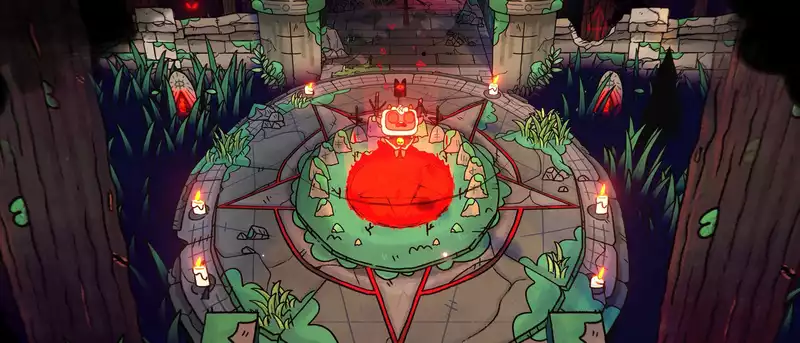Cult of the Lamb is more than one game. It contains the power and potential of many titles and genres, while learning from their mistakes and avoiding most of their flaws, although Cult of the Lamb draws inspiration from games like The Binding of Isaac and Animal Crossing, simultaneously puts you in a position of power and gives you the ability to kill anything and everything to snatch more power. This cycle of gaining power is the gooey, hellish heart of "Cult of the Lamb" and what makes the game so addictive.
Cult of the Lamb was an easy game to review even as it got harder. Every action leads smoothly to the next, making it hard to let go of the game, let alone find a reason to do so. Read the full Cult of the Lamb review here.
Cult of the Lamb has two distinctive gameplay types: combat and management simulation. Both are fun and mutually beneficial. Every part of the gameplay feels meaningful, even if you just go fishing.
While at your encampment (called Cult of the Lamb by default, but you can name it whatever you like), you are in charge of several large tasks that must be carefully managed. However, you can choose whether to do it in a sinister or sacred way.
Cult members need to sleep and eat, which means maintaining a living quarters for each dwarf and a garden large enough for a steady diet. Meat and fish can also be obtained during the combat crusade, but more on that later. You also need to make sure that all members praise your name and earn your devotion. Dedication is an important resource needed for useful upgrades.
There are also several off-duty locations where the lambs can relax, such as fishing grounds and places to gamble with other characters. The fishing mini-game is especially fun. It's easy but fun and helps them prepare meals back at camp.
Sometimes, I was so involved in fishing and gardening that I almost forgot about the crusade, even though the fighting was awesome.
The other half of Cult of the Lamb's gameplay focuses on the "crusade." Each time you leave camp and pass through one of the four area portals, you enter a procedurally generated level filled with enemies to fight and items to collect.
The game features a variety of enemies. Enemies dash, crawl, fly, and move back and forth in between as they make their way through the labyrinth-like rooms of each realm. Most enemies can be defeated with one or two shots, but the challenge is to learn their patterns and develop a strategy to deal with them. A large part of your strategy will depend on the weapons and abilities you find in a particular run.
Each run begins with weapons and abilities. Weapons never break, but their damage and speed ratings remain the same. This is where you need to develop your own strategy. At first, I found that faster, weaker weapons and abilities that shoot homing rounds worked better. Eventually, however, other combinations of weapons and abilities forced me to be more comfortable with different strategies.
Surviving and defeating standard enemies is not that difficult. It is also fun to snatch treasures as you clear each room. But when facing off against mini-bosses and bishops, you need a more deliberate strategy.
After defeating a mini-boss three times, the lamb moves on to the bishop in the area. Each bishop is a test of combat and reaction time. This is especially important if you get lazy on the way to the last room. This is easily done after a few dozen deaths.
Dying is a given in Cult of the Lamb, but it is only a minor hindrance. When you die you have to pay a resource penalty, but you can go out and earn more. Starting a new run will give you different weapons and make combat easier or harder. The sequence of enemies, hazards, and entire rooms can be completely different.
As for the bishops, each is a pretty tough fight and can be defeated with upgrades earned back at camp. This helps tie the combat and management aspects of Cult of the Lamb together. Over time, you will gain better weapons and more powerful abilities. It also adds satisfaction to the progression of the game as you improve with each successive playthrough.
In Cult of the Lamb, developer Massive Monster has established a fascinating power dynamic. The game begins with the player passing by a captive, and it becomes much more apparent how small and weak the lamb is. A powerful and aggressive enemy looms overhead. The game then brings the player back to the executioner. Now, the lamb has gained its power through a dark deal made between life and death, between the lamb and the "one who waits."
The story unfolds as the possessed lamb fulfills its debt to "The One Who Waits" and entrusts the lamb with mighty power and immortality in exchange for building a powerful cult in the name of "The One Who Waits."
Your mission is to destroy the four heretical prophets, and to do so for the glory of the cult of the Lamb. And this engine of violence and power completely transcends the Cult of the Lamb's story and gameplay loops.
And while the story is not the focus or the biggest point of Cult of the Lamb, it is still a fun ride that underpins the backbone of the cult management sim and the battle-fueled crusade.
Cult of the Lamb is a nearly flawless game in terms of mechanics. Unfortunately, there are many bugs and glitches. Some shut down the entire game, while others simply ruin the combat. There were at least a dozen times when the game made me give up just when I was almost ready to take on a boss.
Losing progress. It happens. But like the lamb that was first beaten, you come back stronger and more capable.
Cult of the Lamb has a striking and colorful art style. Despite the game's demanding themes and situations, the game always looks beautiful, even if you are burying dead villagers or trying to harvest meat for the day's dinner. The only thing smoother than the game's presentation is the soundtrack, which keeps you listening long after you've finished playing.
Electronic beats, fluttery melodies, and heavy bass highlight the mayhem and terror of Cult of the Ram. It is playful and bouncy, and fits very well alongside the almost incessant dodge rolls during the battle.
Still, discomfort lurks behind the happiest of melodies, and it works very well. Even after all the enemies have been wiped out, something uncomfortable remains. That's because something is off. The Lamb leads a cult whose goal is destruction, and all living things must either join my cause or die.
Every song in Cult of the Lamb is a bop, but the nightmare never subsides. Not for a moment does it sound normal and pure.
"Cult of the Ram" is one of the most addictive games I have ever played. The engine of destruction never stopped or slowed down, even when I died and had to find my footing again. The cult management part of the game is a fun chore list, always working to increase the player's power and abilities. No matter what, your success is ultimately guaranteed.
Cult of the Lamb is not the first roguelite to get the formula right, but learning from the successes and failures of its contemporaries has placed it near the top of the genre Cult of the Lamb is not only a must-play roguelite, but a must-play game.
.









Comments